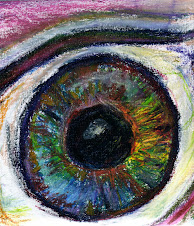Thursday, October 1, 2009
Eye Movements & a Struggling Adult Reader Who Has an MBA
I recently did a very simple eye movement activity with a friend who reads very slowly. It has always been a problem for her from the time she was in elementary school. In fact, she chose her high school and college courses to avoid reading so she became good at math and ended up with an MBA in finance. It remains agonizingly difficult for her to find the energy to tackle reading even a few pages. When she reads aloud, she lacks fluency, obviously struggling to keep her place while decoding the words and trying to process their meaning. So, I suggested that she might have some basic eye movement deficits. Now, I am not an eye doctor. Nor do I play one on TV but I am a skilled observer of a person's eye movements because of the work I do as a vision therapist. I asked my friend to cover one eye and to follow my pen as it moved in a slow arc in front of her eyes, up, down, across, and circling in toward her face. Then she covered the other eye and we repeated the activity. She had no problem making smooth eye movements to track the moving pen so her ocular pursuits look fine. She could even maintain a conversation while doing this activity. Next, one eye at a time again, I asked my friend to look at one pen and then, on my signal, jump her eye to another. She could not keep her fixation on the first object, nor could she accurately locate the second. When she visits a developmental optometrist for a thorough eye exam, I predict that she will receive a diagnosis of saccadic deficits. This is the result of poor control of the six muscles in each eye and can be addressed through a program of vision therapy. (In fact, just as a side note, the Purple Book of the Eye Can Too! Read series of e-books that I wrote has a lot of activities that rely on and can improve these eye movement skills). Next I asked my friend to use two eyes and focus on the #2 written on the side of a pencil that I was holding about a yard away from her face so that the eraser was facing up. I asked her to keep the #2 single and clear and to tell me if it got blurry or doubled. Slowly I pushed the pencil towards her face watching her eyes to make sure that they were converging. They did get closer and closer to her nose which is appropriate. However, when the pencil was about a foot away, my friend said, "That hurts!" She did not look away right then but I could see the stress that she was under. I repeated the activity and she repeated her report of discomfort at about the same place. So, when she visits the developmental optometrist she will likely receive another diagnosis related to her eye teaming skills.She should have been able to track that pencil in to three inches or nearer to her nose without pain, blur, or double vision. No wonder reading has been so difficult in spite of her willingness to tolerate significant discomfort in order to succeed. No matter your age, if you have difficulty reading, see whether there is a visual issue that can be resolved with a few eye exercises. Locate a developmental optometrist by going to www.covd.org and plugging in your zip code. Make an appointment and see what the doctor discovers.
Subscribe to:
Post Comments (Atom)





No comments:
Post a Comment